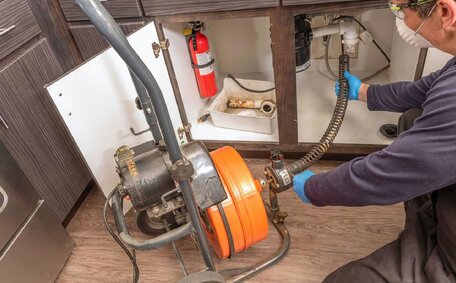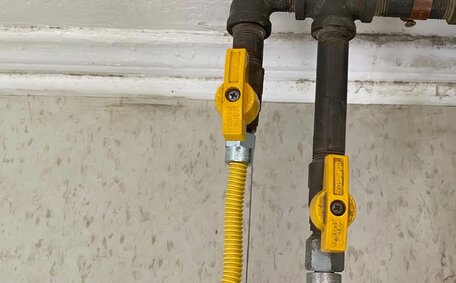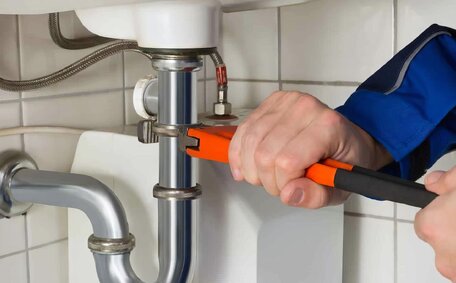Introduction to Plumbing Fixture Replacement
Maintaining your bathroom plumbing fixtures is crucial for your home’s efficiency and to dodge future expensive repairs. Mineral buildup, corrosion, and wear and tear can jeopardise the performance of your fixtures, indicating a need for their timely replacement.
A frequent question is 'How often should plumbing fixtures be replaced?' Typically, plumbing fixtures require replacement every 10 to 15 years. Clear signs that it’s time to replace your fixtures are decreased water flow, leaks, rising utility bills, and visible corrosion. Updating old fixtures offers the chance to reduce your water bills and improve water pressure.
You might handle basic sinks and your faucet yourself, yet it’s wise to rely on your local plumber, for whom any time is a good time for complex jobs like replacing supply pipes or fitting new drainage lines.
With over 25 years of experience, rely on us for efficient plumbing replacement, considering the age of your pipes to ensure optimal repair for your Abbotsbury home.Contact Abbotsbury Plumbing to schedule an inspection of your home’s plumbing and get recommendations on when it’s best to replace your bathroom fixtures.
Recognizing When Fixtures Need Replacement
There are several warning signs from common indicators that highlight the need to replace your bathroom fixtures.
Faucets and Supply Pipes
Your taps should generally be replaced every 10 to 15 years. Signs include:
- Decreased water flow or pressure
- Leaking or dripping
- Visible corrosion and mineral buildup
- Noisy operation or loose handles
Copper and galvanized steel, common types of old pipes, should last between 10 to 50 years before being replaced with new fixtures. Keep an eye out for leaks, low pressure, and corroded pipes, which may indicate that replacing the faucet is necessary.
Drainage Lines
While PVC, cast iron, and clay drainage pipes can last beyond 50 years, it’s prudent to consider replacement if they show these signs:
- Frequent clogs
- Gurgling sounds from pipes
- Backups and leaks
- Sinkholes or cracks in yard (indicating broken lines underground)
Water Heaters
Typically, water heaters last between 8 to 12 years; it’s advisable to replace them around the 10-year mark to avert plumbing problems and structural damage, even when repairable. It might be time to call professional assistance for an inspection when early indicators like the following are noted:
- Rust accumulation
- Leaking or dripping
- Noisy operation
- Inability to maintain temperature
It’s also wise to replace old, inefficient models with new ENERGY STAR-certified heaters to reduce utility costs.
If you detect issues with your bathroom plumbing, an upgrade may be necessary. Contact us to arrange a thorough assessment. We can evaluate your fixtures and suggest when need it’s best to opt for replacements for an essential time upgrade.
Common Signs Fixtures Need Replacing
Several signs, notably dripping faucets, indicate it’s time to replace your plumbing fixtures.
Leaky Faucets
A leaking tap signals the need for faucet replacement, which can significantly reduce water waste. A leaking tap can waste hundreds of litres per year, failing to save money on your water bills. Leaks can cause worn washers and seats inside the faucet to deteriorate, potentially causing damage to your plumbing system if not addressed swiftly.
Low Water Flow
If your sink shows decreased water flow or pressure even after aerator cleaning, it likely points to interior corrosion and mineral buildup, warranting replacement.
Visible Damage
It’s important to acknowledge that rust, cracks, chemical pitting, and mineral deposits can compromise the integrity of your fixtures, prompting you to replace them before they cause more costly issues and save money over time. Replacement with a new faucet can usually restore aesthetics and prevent damage to your plumbing.
Noisy Pipes
Clanging and hammering noises when turning water on or off can indicate worn washers/seats or loose pipes needing replacement.
Frequent Clogs
Drainage lines prone to clogs may be damaged internally and it’s best to consider replacing them. We can inspect your pipes with cameras to identify issues.
Plumbing replacement, often needed to prevent mold growth, usually requires turning off your house’s main water supply. This can disrupt households 1-2 days during installations. We schedule work efficiently to minimise downtime.
Understanding Lifespans of Plumbing Components
Being cognizant of the expected life span for plumbing components enables homeowners to consider when it’s the right moment for replacement.
Faucets
The average lifespan of kitchen and bathroom taps is around 15 years, by which time they often require replacing. Higher use in your kitchen leads to accelerated wear tear so your taps often need replacing sooner, likely around 10 years. When your taps need attention, you’ll notice issues such as leaks, reduced water flow, loose handles, and visible corrosion.
Supply Pipes
Water supply pipes transport pressurised water throughout homes. Galvanised steel types last up to 50 years but should be replaced with new pipes when corrosion causes leaks and flow issues. Copper pipes can last many years, often 50 or more, but may still require replacement to maintain optimal water flow.
PVC, cast iron, and clay drainage lines can last many years, often over 50, until issues your maintenance team identifies dictate replacement. Eventual replacement is needed once cracks, leaks, clogs, and backups occur more frequently.
Traditional hot water heaters should ideally undergo evaluation every 8-12 years to check the condition of the system’s water pipes. Tankless water heater models can last 15-20 years. All heaters should be replaced once issues like rusting, dripping, abnormal noises, or inconsistent temperatures occur, even if these appear within the expected timeframes.
Hard water can hasten the wear and tear on your bathroom and kitchen plumbing components. Water softeners help prolong lifespan. Our team can advise on the best times for replacements, tailored to your pipes’ condition, the age of your plumbing, water quality, and material of your pipes.
DIY vs Hiring a Professional
Homeowners have many reasons to debate whether to engage in DIY or consider replacing your plumbing fixtures with professional help and should weigh several factors:
DIY Benefits
- Cost savings on labour
- Convenience of working on your own schedule
However, more complex plumbing challenges, which may require costlier professional intervention in the long run, are not suited for self-repair attempts. More intricate tasks such as replacing washing machine supply hoses, or when you’re looking to replace plumbing in drainage lines, or water heaters mandate professional expertise.
Benefits of Hiring Abbotsbury Plumbing
- Experienced diagnosing underlying issues like low water pressure
- Access to specialised equipment for locating leaks
- Working with code compliance and permits
- Safe handling of electrial components on water heaters
- Guaranteed quality work backed by our 25+ years of service
Minor fixes that you can repair might be DIY-achievable, yet when they need replaced, plumbing experts can address these jobs with professional acumen. Our certified professionals are equipped to address your plumbing needs, ensuring safety, efficiency, and reliable results.
Contact us today at 1300 349 338 If you’re wondering, 'How frequently should I replace my plumbing fixtures?' and we’ll offer expert advice on when it’s time to upgrade your plumbing fixtures.
Benefits of Timely Fixture Replacement
Replacing worn fixtures on schedule provides several important benefits for homeowners:
Water and Cost Savings
Installing new water-efficient toilets, faucets, and showerheads reduces water usage, making them a financially savvy investment. Replacing old leaky fixtures also reduces your water bill by eliminating wasted water.
Enhanced Performance
Mineral buildup and corrosion can degrade water flow and pressure over time. New components restore proper operation.
Safety
Unattended faulty water heaters, clogged drains, and leaky pipes can cause home damage and present safety risks. Replacement restores safe functioning.
Efficiency
Modern ENERGY STAR-certified fixtures boost heating and cooling efficiency when upgraded.
Environmental Duty
Timely replacement of leaky fixtures, which waste millions of litres of water annually, significantly lowers environmental impact.
Trust Abbotsbury Plumbing for skilful plumbing fixture replacements. We offer customised solutions and strive to minimise household disruption during our work. Contact us at 1300 349 338 for maintenance checks and affordable upgrade options.






